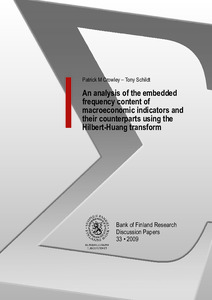An analysis of the embedded frequency content of macroeconomic indicators and their counterparts using the Hilbert-Huang transform
Crowley, Patrick M.; Schildt, Tony (08.11.2009)
Numero
33/2009Julkaisija
Bank of Finland
2009
Julkaisun pysyvä osoite on
https://urn.fi/URN:NBN:fi:bof-20140807119Tiivistelmä
Many indicators of business and growth cycles have been constructed by both private and public agencies and are now in use as monitoring devices of economic conditions and for forecasting purposes. As these indicators are largely composite constructs using other economic data, their frequency composition is likely different to that of the variables they are used as indicators for. In this paper we use the Hilbert-Huang transform, which comprises the empirical mode decomposition (EMD) and the Hilbert spectrum, in order to analyse the frequency content of comparable OECD confidence indicators and national sentiment indicators for industrial production and consumption. We then compare these with the frequency content of both industrial production and real consumption growth data. The Hilbert-Huang methodology first uses a sifting process (EMD) to identify the embedded frequencies within a time series, and the changing nature of these embedded frequencies (IMFs) can then be analysed by estimating the instantaneous frequency (using the Hilbert spectrum). This methodology has several advantages over conventional spectral analysis: it handles non-stationary and non-linear processes, and it can cope with short data series. The aim of this paper is to decompose both indicator and actual economic variables to evaluate i) whether the number of IMFs are equivalent in both indicators and actual variables and ii) to see which frequencies are accounted for in indicators and which frequencies are not.
